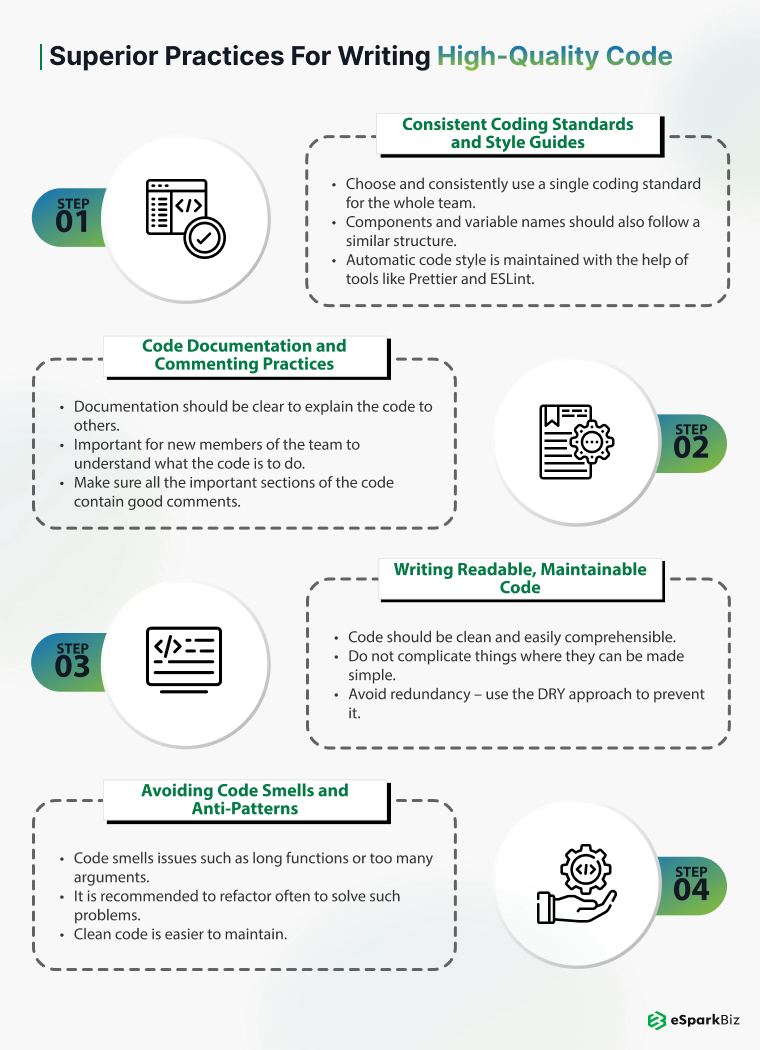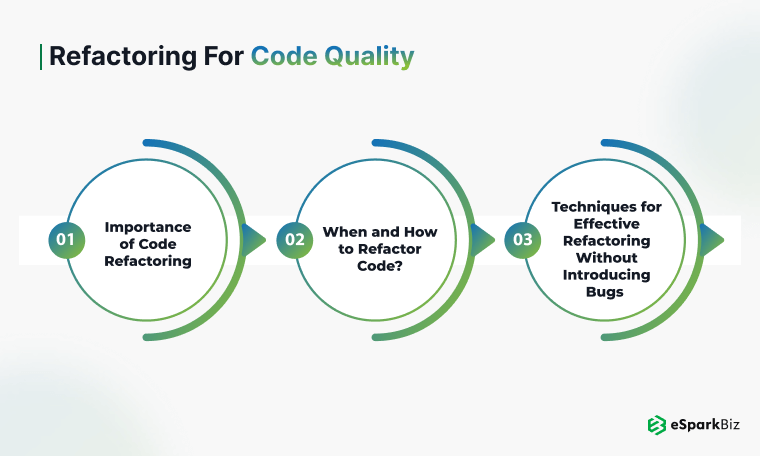Picture this: Your software has been launched, and within days, the users are complaining of issues such as bugs, slow performance, and even crashes. What went wrong? Generally speaking, it’s narrowed to one critical variable: The quality of the code. Badly written, untested, or poorly driven code is a ticking time bomb for tomorrow’s inefficiencies, technical debts, and corrections that will be very costly to the business.
But there’s Good news: Senior developers always have a toolkit and several practices that guarantee that the code they write will not fail within a certain period. Thus, this article aims to discuss how software developers improve code quality, including code reviews, testing, and dealing with technical complexity.
Understanding the Code Quality
What is Code Quality?
Code Quality defines the extent to which a piece of code meets its designed goal in terms of efficiency, simplicity, and ability to manage and alter the code. Good code is easy to maintain and extend. However low quality of code leads to bugs, inefficiencies, and difficult debugging processes.
Why is Improving Code Quality Important for Long-Term Project Success?
Software development code is clean code and is also easy to maintain and extend. Therefore, it reduces the number of bugs and security issues, reduces the cost of future software development, and sets the stage for future features.
Common Issues Resulting from Poor Code
- More bugs cause multiple problems.
- Performance issues often slow down the development process.
- Scaling and adding new features becomes challenging.
Superior Practices for Writing High-Quality Code
For the sake of achieving software development code quality, several practices in software development should be followed by the developers to ensure that the codebase stays clean, readable, and easy to maintain in the long run.

1. Consistent Coding Standards and Style Guides
- Choose and consistently use a single coding standard for the whole team.
- Components and variable names should also follow a similar structure.
- Automatic code style is maintained with the help of tools like Prettier and ESLint.
2. Code Documentation and Commenting Practices
- Documentation should be clear to explain the code to others.
- Important for new members of the team to understand what the code is to do.
- Make sure all the important sections of the code contain good comments.
3. Writing Readable, Maintainable Code
- The code should be clean and easily comprehensible.
- Do not complicate things where they can be made simple.
- Avoid redundancy – use the DRY approach to prevent it.
4. Avoiding Code Smells and Anti-Patterns
- Code smells issues such as long functions or too many arguments.
- It is recommended to refactor often to solve such problems.
- Clean code is easier to maintain.
Example Table: Coding Best Practices
| Best Practice | Description |
| Consistent Coding Standards | Ensuring all team members follow the same style guidelines. |
| Commenting and Documentation | Pouring enough information to justify complicated logic or decisions in the code without making it unnecessarily verbose. |
| Avoiding Code Smells | Refactoring areas of the code that indicate deeper underlying issues. |
10 Good Coding Practices
1. Follow code specifications (e.g., “PEP 8”, “Google Java Style”) for consistent and readable code.
2. Document and comment code clearly and concisely, focusing on “Why” rather than “What”.
3. Write robust code that handles unexpected situations and… pic.twitter.com/nRvgYGl41W
— Sahn Lam (@sahnlam) April 1, 2024
Code Reviews Play a Crucial Role in Ensuring Quality Assurance
In software development services, code reviews have been identified as useful coding quality assurance processes and are defined in simple terms as the code review process by one or more individuals before the code is integrated back into the main code base.
The Importance of Peer Code Reviews
Code reviews from peers can help in identifying bugs or issues that may not have been noticed during coding. Also, peer review makes knowledge sharing and gives an assurance that someone else knows some piece of code.
How to Conduct Effective Code Reviews?
- Code Readability should be prioritized over functionality, code should be optimized for speed, and the emphasis should be placed on bug finding.
- Give feedback and recommend changes where needed.
- Make sure that the code is clear and understandable to other people who might come across it.
Incorporating Automated Code Review Tools
Software like SonarQube and Codacy are good because they can be easily configured to do code reviews flag off errors and review coding standards and formatting.
Example Table: Benefits of Code Reviews
| Benefit | Description |
| Enhances the quality of the code. | Helps to identify bugs, inefficiencies, or security issues at an early stage. |
| Knowledge Sharing | Ensures multiple developers understand key parts of the code. |
| Enforces Best Practices | Promotes the continuous application of coding rules and practices. |
Unit Testing and Test-Driven Development (TDD)
Software Testing remains very important since it helps maintain the quality of the code. On the other hand, write tests to know that the code is behaving in the way it is designed and can handle abnormal inputs without crashing.
Benefits of Writing Unit Tests for Code Quality
- Unit tests prove useful when checking to ensure that all the components of the application are working as designed.
- It is a shield against bugs and maybe future issues the first helps protect the engine.
- Ensure that all code that is implemented in a program is as good
Introduction to Test-Driven Development (TDD)
- TDD is a process of writing tests before writing the actual code.
- It assists in the development of code
- TDD assists in checking and altering the code based on the modules it is written from.
Ways Unit Testing Enhances Code Reliability
- Unit tests help to detect problems early enough
- Ensure that further changes to the code.
- Testing regularly improves the general quality of code and also its maintainability.
Example Table: Unit Testing Best Practices
| Best Practice | Description |
| Write Tests Before Code (TDD) | Start by writing the test to define the code’s expected behavior. |
| Isolate Components | Ensure tests only focus on the behavior of the specific component being tested. |
| Run Tests Regularly | Incorporate tests into the continuous integration process to catch issues early. |
Also Read: Top Software Testing Trends of Current Time
Continuous Integration (CI) for Code Quality
Continuous integration ensures that code changes are automatically tested and validated when merged into the main codebase.
Introduction to Continuous Integration (CI)
Continuous Integration (CI) involves running full tests on any new code pushed to a shared repository. This helps identify and minimize code issues early, preventing them from becoming production-level bugs.
How CI Tools (Jenkins, Travis CI, GitLab CI) Contribute to Upholding Code Quality?
CI tools are very helpful in helping to automate the running of tests, the check for compliance, and the general delivery of the application.
Automating Code Testing and Quality Checks in CI Pipelines
CI allows you to include SonarQube or ESLint in your pipeline which will check your code for smells, vulnerabilities, and errors.
Example Table: CI Tools and Their Features
| CI Tool | Feature |
| Jenkins | Customizable automation server for building, testing, and deploying code. |
| Travis CI | Simple CI service that integrates seamlessly with GitHub projects. |
| GitLab CI | Built-in CI/CD pipelines integrated directly into GitLab repositories. |
Static Code Analysis and Linters
Static code analysis involves analyzing code for errors, bugs, or violations of coding standards without executing it.
What is Static Code Analysis?
This type of analysis explores code for bugs such as bugs, security vices, and code that has an unpleasant smell before the code runs.
Widely Used Static Code Analysis Tools (SonarQube, ESLint, Pylint)
ESLint and Pylint are two linters that check the code for compliance with the coding standards and best practices in JavaScript and Python, respectively.
How Linters and Analyzers Help Identify Potential Bugs and Maintain Coding Standards?
Linters are tools that monitor code implementation and help ensure compliance with a specific code style during handoffs between developers. In contrast, static analyzers identify complex issues and potential safety problems in the code.
Refactoring for Code Quality
Refactoring involves cleaning up and improving existing code without changing its functionalities.

Importance of Code Refactoring
- Refactoring ought to be performed regularly.
- Makes the code more flexible and easy to add
- The code is easier to understand and is less complex.
When and How to Refactor Code?
- Refactor when the code becomes too complex, contains duplicate logic, or is difficult to maintain.
- Break down large functions, remove unused code, and simplify logic during refactoring.
Techniques for Effective Refactoring Without Introducing Bugs
- Use unit tests to check that the refactored code works as intended.
- Test often to ensure that no new bugs are generated
- Make sure that the functionality stays the same
Version Control and Collaboration in Code Quality
Version control System is one of the most important tools that aid in controlling code changes sharing them with other team members, and preventing mistakes from getting into the code.
Using Git for Version Control and Code Management
Git is one of the most popular version control systems which assists developers track changes in the copy. Use Version control to capture the history of code changes, and this means that one is aware of when a bug was introduced and how to undo the change if at all this is required.
- Git branches allow developers to work independently from each other and the main repository for experimental code.
- It tracks changes like deletions and transfers, ensuring nothing is lost or forgotten.
Example: In Git, developers commit in small portions which makes it easier to tell when an error was made.
How Branching Strategies Help Maintain Code Quality?
Specifically, the Gitflow or the Feature Branching model forms the foundation for keeping up the high code quality in shared projects. Both enable developers to improve the Software product development approach, add a new feature in new branches, or even eliminate bugs without any impact on the main code.
- Feature branches also enable the creation of new additions to be worked on.
- Hotfix branches are always short branches that are used to fix problems.
Table: Common Git Branching Strategies
| Strategy | Description |
| Feature Branching | Isolates new features until they’re fully developed and ready for production. |
| Gitflow | Uses separate branches for Software development, hotfixes, and releases. |
| Trunk-Based Dev. | Encourages small, frequent commits to the main branch with rapid feedback. |
Collaborating with Teams to Maintain Quality Across Codebases
When working in a team, communication, as well as code management, are critical. Tools such as GitHub, GitLab, and Bitbucket have features like pull requests, issues, and review systems for collaboration.
- Pull requests allow the developer to submit changes that are then discussed and argued over before being merged into the main branch.
- Some parts of the code can be provided to code owners and it will be assumed that they review the right changes.
Example: At eSparkBiz, we employ testing to ensure that every code is checked and tested before it is merged to the main branch to improve code quality.
Automation in Code Quality Assurance
Automation plays a vital role in improving code quality, helping to enforce standards, run tests, and reduce the manual effort involved in checking code integrity.
Automating Code Quality Checks with CI/CD Pipelines
When working in a team, communication, as well as code management, are critical. Tools such as GitHub, GitLab, and Bitbucket have features like pull requests, issues, and review systems for collaboration.
- Allow the developer to submit changes that are then discussed and argued over before being merged into the main branch.
- Some parts of the code can be provided to code owners
Leveraging Tools like SonarQube and ESLint in Building Pipelines
Code quality can be ensured by using tools like SonarQube and ESLint.
- SonarQube is a static code analysis tool that provides detailed reports on code quality, highlighting areas like bugs, vulnerabilities, and duplicated code.
- ESLint helps ensure JavaScript code adheres to best development practices, identifying problems such as unused variables, incorrect formatting, and potential bugs.
Example Table: Common Tools for Code Quality Automation
| Tool | Functionality |
| SonarQube | Static code analysis, bug detection, and vulnerability scans. |
| ESLint | Enforces JavaScript coding standards and flags issues. |
| Jenkins | Automates builds, tests, and deployment. |
CI/CD – Continuous Integration and Continuous Delivery
- Incremental testing is a way of testing whereby after each code change, the new code goes through several tests to check whether it has any bad effects on the existing code.
- CI/CD development also automatically conduct unit tests, integration tests, and end-to-end tests as well on the code that is being pushed on Git making it easy to discover bugs.
- An example of such tools is Jest for the scripting language known as JavaScript or Pytest for the scripting language known as Python, which can be easily integrated into the CI/CD pipeline.
Handling Technical Debt to Maintain Code Quality
Technical debt is the sum of all the suboptimal decisions made in a codebase to meet certain deadlines or deliver products as quickly as possible.
What is Technical Debt?
Technical debts are where developers use quicker and easier methods to get things done to deliver features faster.
How Technical Debt Affects Code Quality Over Time?
Technical debts can result in a noticeable decline in code quality, leading to problems such as:
- The code becomes more complex and hence it becomes very hard to change.
- Due to poor coding standards, the end product is full of bugs and security vulnerabilities in the software.
- The customer has to face a situation where with the growth of technical debt.
Also Read: How to Estimate Software Development Time?
Strategies for Managing and Reducing Technical Debt
Technical debt therefore involves constant code refactoring and identifying areas where shortcuts were made. Key strategies include:
- Refactoring regularly: Refactoring is the part of software development methodology of cleaning up old code that may have become cluttered and optimized so that it can remain readable.
- Paying off debt incrementally: Overcome technical complexity during the sprint, not at the end of it.
Security Best Practices for Code Quality
Measures that are associated with code security to coding are important in maintaining the quality of the code.
Application of Static and Dynamic Security Analysis in Coding
Static and dynamic security analysis helps to identify security issues in the code at the stage of application development.
- Static analysis involves the review of the source code to identify possible vulnerabilities like SQL injection.
- Dynamic analysis involves testing the code in a running environment.
Ensuring Security with Code Reviews and Automated Testing
It can be detected by manual code review and automated testing. Some of the tools that can be used for testing include OWASP ZAP which can scan for known security flaws and code reviews to verify.
Regular Security Patching and Vulnerability Assessments
Tools like Dependabot in GitHub help automate this process by identifying and alerting developers to outdated or vulnerable dependencies.
Documentation and Knowledge Sharing for Code Quality
Documentation and knowledge sharing ensure that codebases remain maintainable and understandable, even when new developers join a project.
Importance of Proper Documentation in Codebases
Recording code, design, and architectural decisions are important so that the project can be explained and managed in the future.
Creating Self-Explanatory Code and Comments
When the code is clean and easy to read, the developers will not be compelled to comment on it. It should be used to justify decisions rather than on how the code looks or how it was created.
Knowledge Sharing Across Teams for Consistent Code Quality
Knowledge sharing can be conducted in the form of knowledge exchange sessions where for instance the senior developers can educate the junior developers. This ensures that all team members are aware of the best security practices for maintaining a healthy code.
Also Read: Analyzing The Evolving Software Development Trends In Detail
Real-World Examples of Code Quality Practices
Real-World Example: eSparkBiz Ensures Code Quality in Large-Scale Web Development Projects
Client Challenge:
A global e-commerce business needed to rapidly expand its offerings while maintaining high-quality code to ensure scalability and reliability.
eSparkBiz Solution:
- Defined coding standards that were to be used by the dedicated development team.
- Provided periodic peer code reviews to ensure that the quality of the code is kept high.
- Integrated SonarQube for ensuring code quality measurement and the vulnerabilities and code flow identification.
- Employed CI/CD pipelines for the continuous testing Software integration and deployment of the software.
Result:
- 40% reduction in bugs post-deployment.
- The codebase remained stable, allowing new features to be added without compromising quality.
Real-World Example: How Google Implements Code Quality Practices?
Google can assemble industry players to develop and sustain good code standards. However, for the development of larger systems like YouTube and Google Search, Google often uses a technique that includes unit and integration testing done with every code-making iteration.
Google code reviews are done based on the analysis of code pieces by the reviewers and developers before everything is merged. Google’s strengths are Git’s branching policies to ensure that new changes and enhancements do not affect the code base since the latter has been tested.
Result: This approach has enabled Google to maintain high uptime and reliability across its platforms, even as they scale to billions of users.
Real-World Example: Microsoft’s Code Quality Standards in Azure Development
Microsoft provides a well-developed CI/CD toolset, including Jenkins and SonarQube, to help customers quickly maximize Azure.
This is made possible by the integration of automatic code assessment technologies helping the Azure platform to overcome any back-end issues regarding reliability and security.
Result: Customers using Azure enjoy a very secure and stable platform since Microsoft follows good coding practices.
Conclusion and Key Takeaways
By enforcing coding standards, conducting peer reviews, running automated tests, and managing technical debt, developers can prevent bugs, enhance performance, and maintain code more efficiently and securely.
Key Takeaways include:
- Code standards should stay consistent and documented to reduce future maintenance time. This approach helps detect and fix errors early through code reviews, ensuring quality deployments with automated tools like SonarQube or ESLint.
- Unit tests and CI bring yet another level of confidence in terms of bug finds before it gets to production.
- technical complexity does not allow for performance problems or blockages in the future, which keeps the codebase flexible.
- Security best practices ensure that your software is secure by default as security is integrated right from the code level, thus minimizing risks.
When these best practices are incorporated into the software development process, it is possible to develop long-lasting code that can act as a foundation for future growth and scalability.
Why Choose eSparkBiz for Code Quality?
In aspect of software development we at eSparkBiz, are convinced that code quality is the key to creating high-quality software products. With years of experience in software development projects and having a dedicated team of Software developers, we implement the highest standards of code quality through:
- Regular code reviews: All the codes are reviewed by other members of the team to ensure that they meet our high-quality standards.
- Automated testing frameworks: We incorporate state-of-the-art tools to perform fully automated tests and detect problems at the early stages of the Software development process.
- Best practices in coding standards: Our team adheres to internationally accepted code standards to improve code Readability and make them modifiable, and understandable leveraging the technologies like ReactJS, VueJS, NodeJS, Python, and Laravel.
- Proactive management of technical debt: We ensure that writing code right from the beginning so that there will be little or no technical debts in the future.
- Security-first approach: Some of the code quality that we have integrated into our practices include security to your software in case of future vulnerability.
Choose eSparkBiz as your Software development partner, and we will ensure that you get the best quality software that is efficient, sustainable, and secure to propel your business. Feel free to Consult eSparkBiz Experts to achieve the best code quality for your next project.
-
What are the key practices developers follow to maintain high code quality?
- Developers use a combination of practices to ensure high code quality, such as adhering to clean coding principles, which prioritize readability and simplicity.
- CI/CD also often sees the use of continuous integration pipelines used by developers to build and test the code addition that had been made and integrate it back into the repository to prevent new bugs from being introduced.
- Refactoring is the process of restructuring existing code without altering the behaviour of the program: a regular practice that serves to increase code reliability, as well as performance.
-
How do automated testing tools help in ensuring code quality?
- Automated testing tools ensure that code performs as expected under various conditions without manual intervention.
- Some of them can span unit testing,and integration testing and can even go as far as functional or regression testing.
- These tasks enable developers to readily detect bugs or inventing behavior,especially after new changes if done automated.
- Developers at eSparkBiz leverage various tools like Selenium,Junit,and Jenkins for Robust & Secure Software Testing Services which guarantee the consistent running of tests,thereby eliminating the possibility of mistakes.
-
What is the role of code reviews in improving code quality?
- Code reviews refer to the analysis of written code done by other programmers prior to the merging of codes into the main project.
- The review process enables instance finding of some problems that other automated tools might not pick out,for instance,logical mistakes,security weaknesses,or even performance hindrances.
- They also allow for knowledge sharing within a team regarding the improvement over previous approaches by the reviewers.
-
How does continuous integration (CI) contribute to maintaining code quality?
- Continuous integration (CI) is a process of integrating new code changes into the main repository several times a day.
- After each integration,the code is tested again through an automated unit test so that the new code does not corrupt working features or contain bugs.
- CI makes it possible for teams to identify some software development challengesas they develop,and this makes it easier to contain problems before theycompound or become expensive to solve.
-
What coding standards do developers follow to ensure consistent and high-quality code?
- Coding standards are the best practices that developers stick to when they are coding.
- These standards include naming conventions,indentation,error handling and commenting standards.
- This way,all the members of the development team can read and comprehend the code and also can understand what has been written prescriptively across the project to make the code more consistent.








